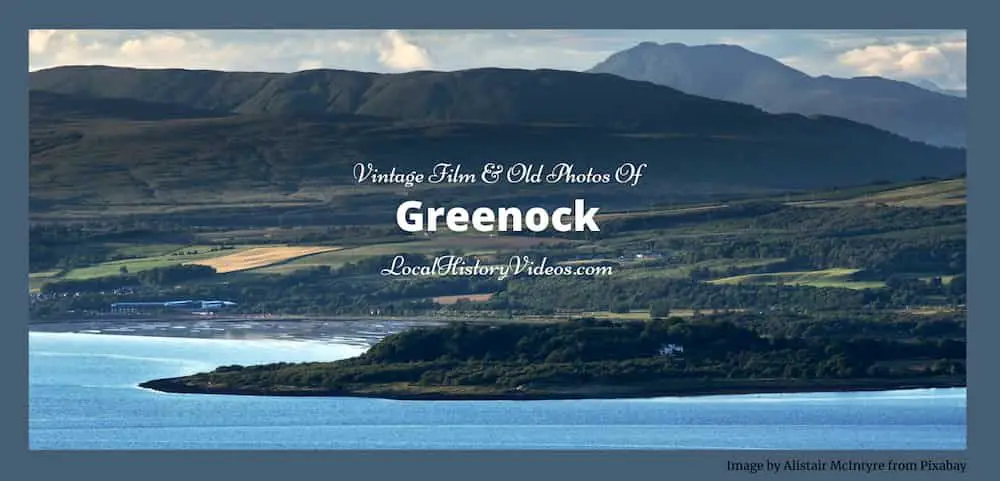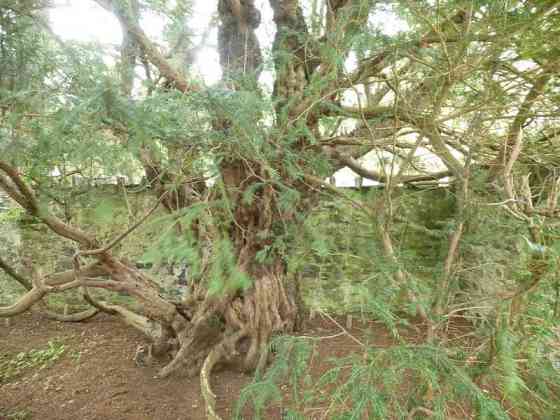Step back in time with fascinating old photos and film of Greenock, Scotland.
Greenock, the largest settlement in the Scottish area of Inverclyde, was once an important manufacturing, export and shipbuilding centre. It suffered badly in the bombing of May 1941, before watching many of its industries disappear in more recent decades. Many photos and films still exist to chart the many changes this town has witnessed.
Old Pictures of Greenock
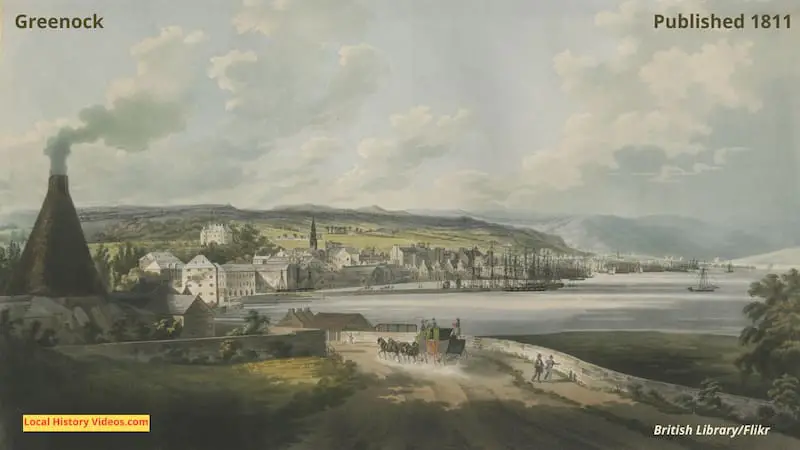
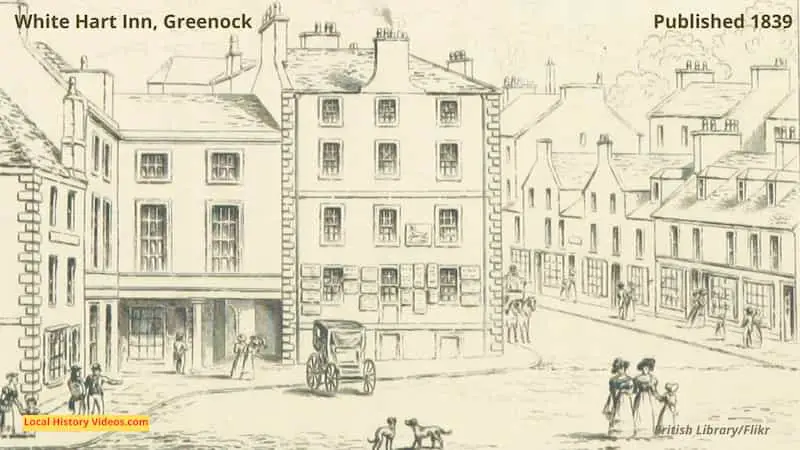
Black And White Photos Of Old Greenock
Selection of black and white photos set to music. Lots of people, places and industries in the old days.
Greenock In Old Photos
Another selection of old photos, many in colour.
Launching A Ship In Greenock (1937)
From the British Pathé collection comes this quick clip of a ship being launched in Greenock in 1937. It had a surprising and deadly fate ahead.
Because the christening bottle of champagne is swung by an Indian gentleman wearing a turban, this is probably the Tribal-class destroyer of the Royal Navy HMS Punjab.
That year, the Tribal-class destroyer Matabele and the Grampus-class submarine Cachalot were also launched at Greenock. All were built at Scotts Shipbuilding and Engineering Company, which completed 1250 vessels over its existence. Unfortunately, neither the Matabele nor the Cachalot survived enemy action in the Second World War.
Following many deployments throughout the war, on 1 May 1942 in heavy fog, the lookout on HMS Punjab erroneously saw what he believed to be a mine dead ahead. Turning sharply, the ship sailed directly into the path of the battleship HMS King George V, which rammed HMS Punjab, cutting the ship in two. While many sailors were rescued, 49 crew in the aft section died when the depth charges detonated.
US battleship USS Washington was slightly damaged, while HMS King George V sustained serious damage to her bow, and was forced to return to port for repairs.
Greenock In World War II
On the nights of 6th and 7th of May 1941, Luftwaffe bombing raids involving hundreds of aircraft took aim at the shipyards and berthed ships. Unfortunately, most of the bombs and incendiary devices fell on residential parts of town, causing damage and huge fires.
The Greenock Blitz
6 & 7 May 1941
.
271 people killed
More than 10,200 people injured
Nearly 5,000 homes destroyed outright
25,000 homes damaged
.
Greenock Blitz 1941
William Young identified the damaged sites. Where some of the old landscape still exists he’s compared old photos of the site to photos taken in the same location in 2014. He’s added clear titles to identity each scene.
VE Day 75 Inverclyde – The Greenock Blitz
A photo montage showing how extensive the blitz damage was. Good clear location titles too.
U.S. Army Nurses 1944
This photo, taken on 15 August 1944, shows U.S. army nurses waiting to disembark their ship as the gangplank is lowered.
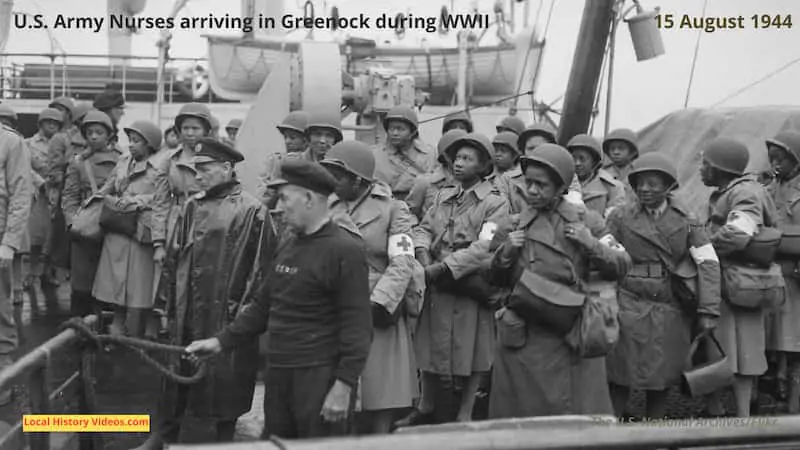
Unveiling Memorial To Free French (1946)
Watch the unveiling of the memorial to the Free French Navy, which was a sculpture in the shape of an anchor. Discover more about Scotland’s wartime ties to France through this local tragedy.
The Free French Navy
Around 1940 the Free French Navy arrived in town. The sailors were given use of the Martyrs North Church hall, which was used as a canteen and bunking house for those on shore leave. Even Charles De Gaulle visited the church to meet the men stationed there.
The Free French Navy ship, the Maille Breze, exploded. Many sailors died, with others badly injured. Local women gave first aid to the survivors in the halls. From there patients were transferred to the old Greenock Royal Infirmary in Duncan Street.
Those who died were buried in the local cemetery, with a service held in St Mary’s church. Then in 1946, they were interred and returned to France, and the memorial was erected on the waterfront.
Lord Inverclyde
Present is Lord Inverclyde (John Alan Burns, 4th Baron Inverclyde, 12 December 1897 – 17 June 1957). He was wounded in the trenches in the First World War before transfer to the War Office. In the Second World War he was back serving in France, then rescued from RMS Lancastria when she was sunk off St Nazaire on 17 June 1940.
Lord Inverclyde married first the daughter of Arthur Sainsbury (of the supermarket chain) and then June Howard-Tripp, a star of the silent films. Both marriages ended in divorce.
He enjoyed his flat in Mayfair, his yacht and his autumnal grouse hunts, choosing not to be involved with the running of the Cunard Steamship Company Ltd, co-founded by his forebears.
The 1950s, 60s & 70s
Greenock In 1959
It’s a bit fuzzy, but this old cine film includes lots of locations and gives a good impression of where people were spending time. Also, William Murray has added some interesting information too.
Greenock Plans Ahead & Sea City
Head back to the 1950s in Greenock Plans Ahead, and then jump to the 1970s for Sea City.
Film 1: 24 minutes long: Greenock Plans Ahead (1950s)
Hamilton Tait’s film with the title card: Greencok Plans Ahead. Almost 45 minutes long, this film looks at the industrial and housing issues facing the local Corporation. It then considers the plans to resolve these problems, as drawn up by Sir Frank C. Mears (11 July 1880 – 25 January 1953).
At the time, Greenock was the 6th largest borough in Scotland, with a population of nearly 80,000 people.
There are hardly any vehicles on the wide, tree lined roads of the smart, planned residentials streets.
The ‘clutter’ of mixed housing and industry clearly worried the planners, although the busiest streets still look very quiet to modern eyes.
However, the freight steam trains pottering about along normal roads certainly does look a bit worrying!
The blitz of May 1941 caused lots of damage, and the wrecked housing blocks appear.
The new plans envisioned expansion of the port, sugar refining factories and the knitwear industry. They also looked at the hand made furniture using cooperage skills.
The planners wanted the town centre to be focussed on business, services and transport. Retails would replace the bomb damaged streets.
“This old school will be demolished as it stands in the way of development”.
800 houses were in the process of being built at Larkfield.
Bishopton was proposed as a satellite town for 30,000 people.
Baby clinics were the focus of the healthcare service. Maternity services had only just been moved into the state healthcare sector from the local authority.
New Wellington Park would offer different ways to enjoy leisure time.
Film 2 Starts at 24 minutes in: Sea City (1970s)
A film in colour, showing the port and the locally produced products exported across the world.
Because it has a narrative revolving around a schoolby, a wide range of people and places appear.
The Town In The 1960s
A great collection of 1960s colour photos.
Greenock in the 1960s and 1970s
Lots of people, places and vehicles appear in the old photos of Greenock in Scotland back in the 1960s and 1970s.
The 1980s & 1990s
In the post-war years, Greenock prospered, but unemployment became a major problem as the heavy industry deteriorated in the 1970s and 1980s. It was only in the 2000s that the local economy began to recover with reinvestment and the regeneration of large parts of the area. With the establishment of the Clydeport container port as the Ocean Terminal, a passenger terminal for cruise ships visiting the Atlantic, tourism has emerged as an unforeseen bonus.
The town has traditionally relied on shipbuilding, sugar refining and the manufacture of wool for employment, but none of these industries are now part of the local economy. More recently, the town has relied heavily on the production of electronics. This has however, largely been supplanted with call centres, insurance, banking and export shipping.
Luckily we do have footage of industrial parts of town before they disappeared.
Greenock 1981 – A Shipbuilding Town
Take a drive from the BPI factory at 90 Port Glasgow Road into the town centre in October 1981. Captures the shipbuilding firms and suppliers before the industrial landscape changed forever.
Go back in time with this drive from the BPI factory at 90 Port Glasgow Road into the town centre in October 1981. Captures the shipbuilding firms and suppliers before the industrial landscape changed forever.
Greenock Silos In 1992
Brian Jones used a Video 8 camcorder to record what he saw from the top of the silos at Anaplast (British Polythene Industries).
This is now a housing estate.
At the time, petrol was 47.9p a litre!
Facebook Groups For Local History
Discover more fascinating old photos and vintage film of the local area with the following Facebook pages and groups:
Greenock…A history in old pictures.
Greenock Pictures – Old and New
Greenock, Gourock and Port Glasgow – the way we were
RIP Greenock Academy 1855 – 2011

